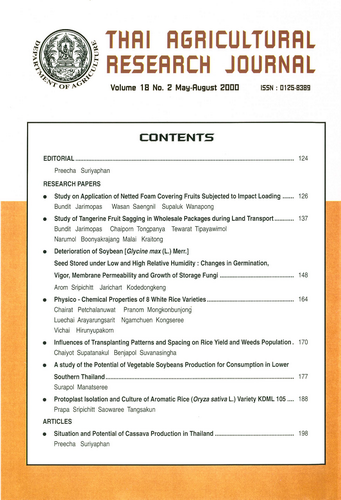Situation and Potential of Casava Production in thailand
DOI:
https://doi.org/10.14456/thaidoa-agres.2000.15Keywords:
varieties, chips, pellets, starchAbstract
Cassava is one of the most important economic crops in Thailand. It is produced by small farmers on marginal land and its products are exported mainly to the European Union (EU). Production has steadily increased during the 1970s and 80s through expansion of the planted area, but has decreased again since the early 1990s. The national average yield has been stagnant at about 14.5 t./ ha, which is ghigher than the world avearage, yet low compared with the otention of the crop. While the EU sets an upper limit to the amount of cassava imported from thailand, it is widely felt that thailand can no longer afford uncontrolled production increases by limitless area expansion. For that reason, the government established a policy in 1993 to reduce the cassava growing area by at least 20%.
Major production problems are declining soil fertility, soil erosion and limited genetic diversity of the crop. Previous research conducted by the Department of Agriculture (DOA) has resulted in the identification of a high-yielding and very versatile local cultivar, Rayong 1, and more recently, the breeeding and selection of several high-yield and high-starch cultivars. Latin American germplasm provided by CIAT is now well incroporated into the breeding population. High yielding capacity, high-starch content and early maturity are important selection criteria. Agronomic practices, such as land preparation, stake selection and storage, planting method, planting time, fertilization, crop rotation, intercropping and weed control have been studied. More emphasis is now being given to soil fertility maintenance, erosion control and labor-saving technologies. All thes will lead to more efficient and more stable production, thus enhancing the competitiveness of Thai cassava products in the world market.
Downloads
Published
How to Cite
Issue
Section
License

This work is licensed under a Creative Commons Attribution-NonCommercial-NoDerivatives 4.0 International License.
Thai Agricultural Research Journal



